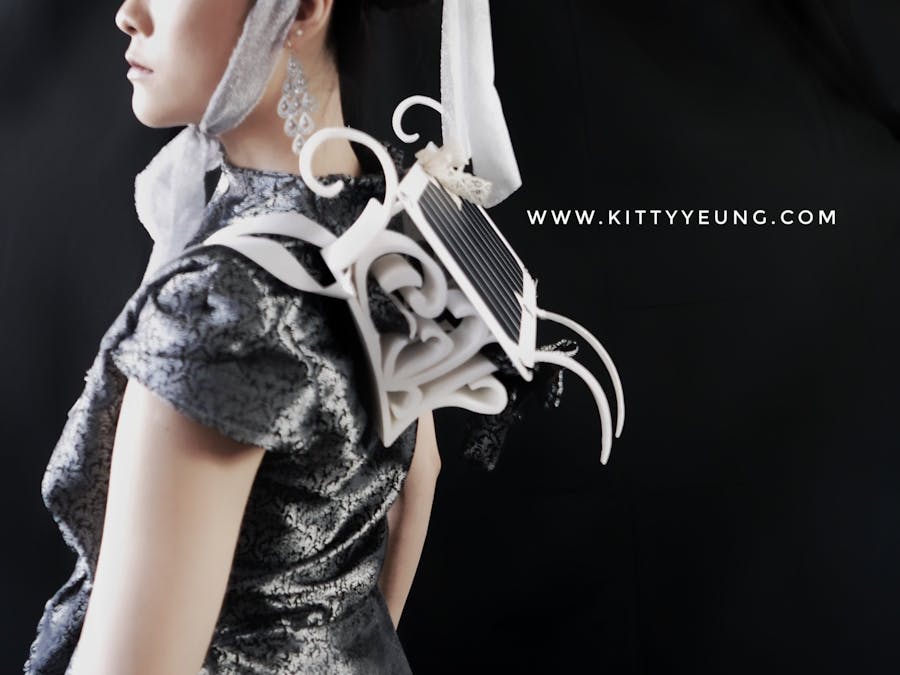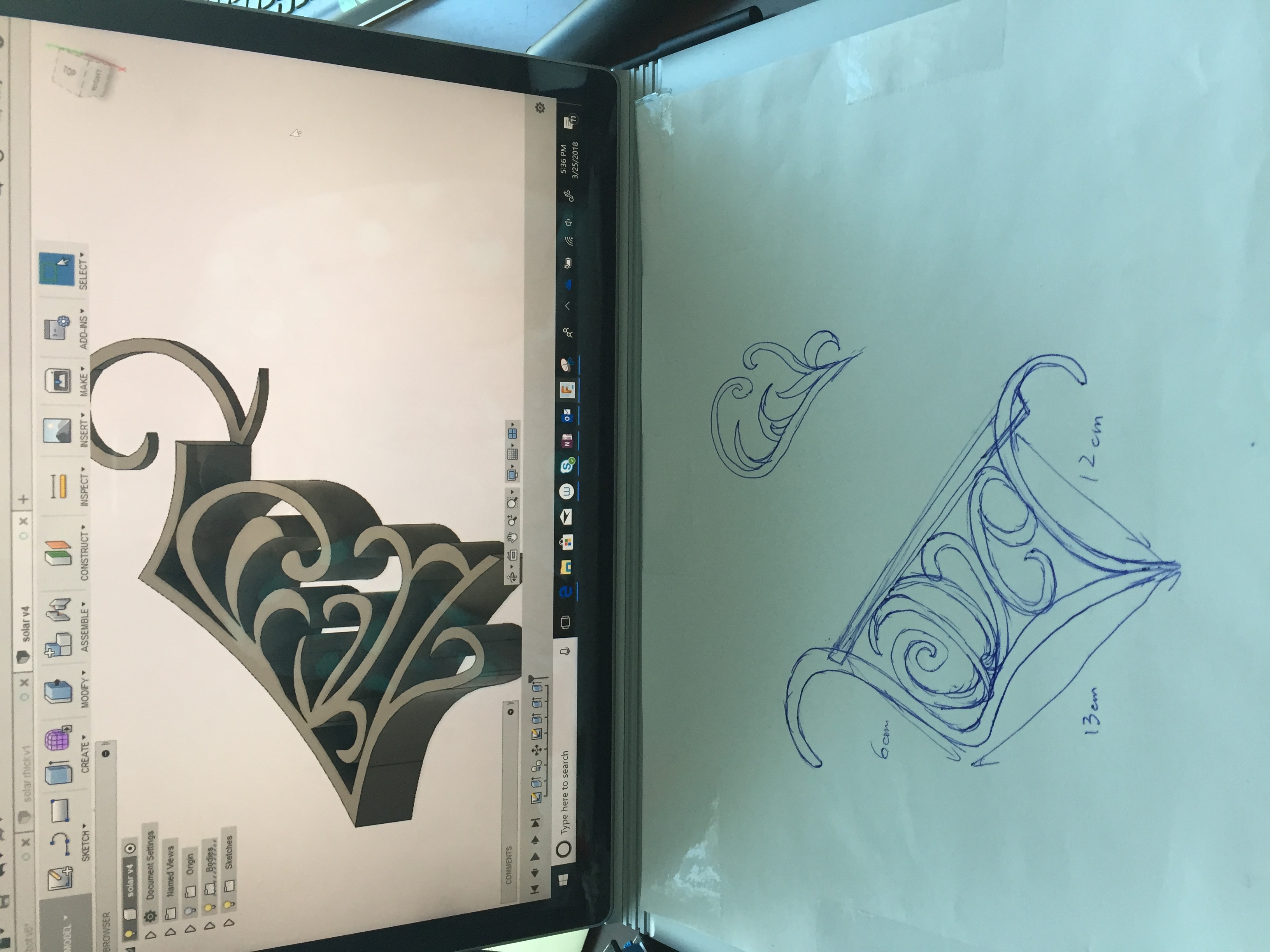I've never been to Burning Man, but might have just made the perfect outfit for it.
This will be one of my outfits at Maker Faire this year. What will you wear?
The making of this outfit involves garment design, 3D printing and solar energy, constructed using facility at the Garage, Microsoft. #MadeInTheGarage
Start with pattern cutting. Unless you have access to those rare and newly invented 3D knitting machines, you have to cut fabrics into pieces of patterns and sew them up into outfits. This outfit consists of a multi-layer top and a pair of shorts. I had all these in mind (no need to do sketches). It was just a matter of finding some basic patterns which I could modify on. I used a Vogue Pattern as my basic guide so that I had a reference to cut fabrics into the right size and to construct the rough shape. Then I modified it to make my own design - like changing pattern shapes, adding pockets, sleeves, front layers, etc.
I made two front layers for the bodice. On the shoulders, I left a gap between the two layers so that a USB cable for the solar panel can be fed through (see section 3). Between these two layers, I also sewed two ribbons made out of the same fabric which can be used to attach the 3D printed parts (see section 2).
The fabric was bought from a Jo-Ann store. It is a type of silk that has beautiful Victorian repeated patterns on it. They probably categorized it in the "cosplay fabric" session. I did not notice the effect until I finished the basic sewing that it turned out to look so much like an armor. Hence, I'm calling it "Goblin-Wrought Silver (it absorbs things)" in my techfashion series. The color was chosen to match the solar panel - black, white and silver.
Seam/hem FinishesThere are a few details I need to mention specific to garment construction processes. The edges of the cuts need to be protected, especially for flimsy fabrics like silk. They get worn immediately after cutting and messes up with sewing. I actually put fabric glue around all edges after cutting. After the glue dries I could sew the pieces up and make hems. However, glue makes the edges hard which scratches the skin. So I used a transparent iron-on tape along the edges. This then creates a smooth protection along the edges. You can wash the clothes without worrying about it falling apart.
InterfacingInterfacings are an extra layer that's sewn on the inside of a garment. There are places where the inside can be seen from outside (light grey areas in above photos). It is not good to show rough edges. One should make interfacing layers, in this case a different fabric, to hide edges inside. I really love interfacings.
(Ahhhh....something's wrong with Instagram video embedding here. It used to work. Wanted to post a video of the sewing machine in action. Check it here then...)
PressPressing with an iron makes a garment sturdy. It's not only used to remove wrinkles but also to press the seams flat, giving the garment structure.
ButtonsI chose brassy snap buttons to match the armor look. You hammer them on. Super fun.
As an additional touch, I wanted to use my 3D printed buttons from my previous design (below and see more photos here) as decorations. For whatever reason, the fashion industry forces designers to create seasonal "themes" of designs using the same elements (why can't every single piece be unique and timeless?)... I like how the combination of the buttons and chain turned out.
This is the other 3D printed dress I made.
To complete the look, a cone hat makes sense. You cut a few pieces of triangles and sew them together. Stuff it with rags and seal up the edges with ribbons to wrap around your head like below:
Who doesn't want pockets? Especially when you can put your phone in it while charging. I made weird triangular pockets that are also decorative.
There are jackets with solar panels on them currently in the market. But they all have the solar panels flat on the back. Does it actually collect enough sunlight when they are vertical? I wanted my solar panel to face the sun. Since this would make it look ridiculous, I might as well make it avant-garde.
I measured the dimensions needed and used Fusion 360 to design two plastic pieces that can elevate the solar panel on the shoulders. (.STL model attached below.) They have a shape that is similar to the Victorian patterns on the fabric.
I debated between white, silver and black. Eventually it just depended on which machine and color were available. I used our MakerBot 3D printer to print and Dremel to polish.
Now you can try to attach the 3D printed parts with the ribbons made in section 1. I fed the ribbons through the holes on the 3D printed parts a couple of times until they are stabilized by the triangular "entanglements" of the ribbons and the frictions between the ribbons and the parts. (Not sure how to describe this in words...)
3. Attach Solar PanelThe solar panel comes with six holes and two hooks.
I used the two hooks to attach the ribbons onto the bottom of the panel. And the top two holes were fed with the two spikes on the 3D printed parts. Originally, I planned to feed the bottom spikes through the bottom holes but the geometry was a little off and the spikes were a little too thick. If I polished the bottom spikes too much, I was afraid of breaking them. Oh well, maybe for the next version. This works for now. Usually there would be many iterations in the process of prototyping. This is the first edition.
To stabilize it even further, I added a ribbon to attach the neck to the top middle hole.
The solar panel and 3D parts are pretty light but over a long period of time with lots of movements on the body, they could move out of position. I added additional ribbons which can be used to pull them back as well as to decorate the outfit overall. You see, I like ribbons.
The solar panel has a 5V electrical USB output which can be attached to any USB cables to charge your devices.
I fed the USB cable through the gap on the shoulder (mentioned section 1) so the cable is hidden under the cloth until it comes out at the bottom of the bodice but then can be hidden inside a pocket together with the phone.
Now I don't need to worry about running out of battery outdoors for a whole day. See you at Maker Faire!










_t9PF3orMPd.png?auto=compress%2Cformat&w=40&h=40&fit=fillmax&bg=fff&dpr=2)





Comments